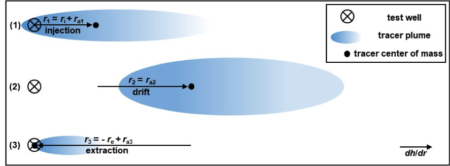 Hydraulic conductivity and effective porosity are requisite parameters for modeling specific discharge and average linear groundwater velocity. In situ characterization of both parameters is ideal, but such efforts are rarely performed in practice. In this study, both parameters were characterized in situ by utilizing single-well testing methods. The study site consisted of six test wells constructed within a shallow and unconfined groundwater system comprised of unconsolidated and heterogeneous silty and clayey fill materials (soil, limestone, and clay-rich residuum). Single-well pumping tests were conducted by establishing steady-state discharge and drawdown conditions within each test well to calculate hydraulic conductivity according to the half-ellipsoid flow equation. Single-well push-pull tests were conducted by injecting bromide tracer, followed by a non-pumping period, and subsequent extraction of groundwater to calculate effective porosity by analysis of the bromide breakthrough curves. Hydraulic conductivity values were representative of granular porous media (2.1E-06 to 1.8E-05 m/s) whereas effective porosity values were representative of fractured porous media (0.02 to 1.54%). These results suggest that groundwater flow is highly channelized within inter-connected pore spaces and/or fractured networks. These results also demonstrated that the spatial variability of effective porosity, within a relatively small study site, can be substantial and can have a notable effect on the nature of groundwater flow. It is also possible, and advantageous, to calculate both hydraulic conductivity and effective porosity from a single push-pull test. This would eliminate the need to conduct a pumping test prior to a push-pull test and would allow for calculating both parameters under the same hydraulic test conditions. Effective porosity (ne) describes void spaces through which solutes transport by advection.
Hydraulic conductivity and effective porosity are requisite parameters for modeling specific discharge and average linear groundwater velocity. In situ characterization of both parameters is ideal, but such efforts are rarely performed in practice. In this study, both parameters were characterized in situ by utilizing single-well testing methods. The study site consisted of six test wells constructed within a shallow and unconfined groundwater system comprised of unconsolidated and heterogeneous silty and clayey fill materials (soil, limestone, and clay-rich residuum). Single-well pumping tests were conducted by establishing steady-state discharge and drawdown conditions within each test well to calculate hydraulic conductivity according to the half-ellipsoid flow equation. Single-well push-pull tests were conducted by injecting bromide tracer, followed by a non-pumping period, and subsequent extraction of groundwater to calculate effective porosity by analysis of the bromide breakthrough curves. Hydraulic conductivity values were representative of granular porous media (2.1E-06 to 1.8E-05 m/s) whereas effective porosity values were representative of fractured porous media (0.02 to 1.54%). These results suggest that groundwater flow is highly channelized within inter-connected pore spaces and/or fractured networks. These results also demonstrated that the spatial variability of effective porosity, within a relatively small study site, can be substantial and can have a notable effect on the nature of groundwater flow. It is also possible, and advantageous, to calculate both hydraulic conductivity and effective porosity from a single push-pull test. This would eliminate the need to conduct a pumping test prior to a push-pull test and would allow for calculating both parameters under the same hydraulic test conditions. Effective porosity (ne) describes void spaces through which solutes transport by advection.
- In situ characterization of ne needed to inform microbial modeling
- Current analytical model for ne was expanded and improved
- ne at Oak Ridge Reserve fill materials near S-3 Ponds is very low (0.6 to 5%)
- Suggests solutes, e.g., electron donors/acceptors, transport through a surprisingly small fraction of total volume
- Push-pull tests for estimating effective porosity: expanded analytical solution and in situ application
Paradis, C. J., L. D. McKay, E. Perfect, J. D. Istok & T. C. Hazen. Hydrogeology Journal
